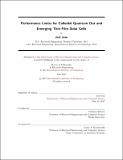| dc.contributor.advisor | Vladimir Bulović. | en_US |
| dc.contributor.author | Jean, Joel, Ph. D. Massachusetts Institute of Technology | en_US |
| dc.contributor.other | Massachusetts Institute of Technology. Department of Electrical Engineering and Computer Science. | en_US |
| dc.date.accessioned | 2017-10-18T14:42:30Z | |
| dc.date.available | 2017-10-18T14:42:30Z | |
| dc.date.copyright | 2017 | en_US |
| dc.date.issued | 2017 | en_US |
| dc.identifier.uri | http://hdl.handle.net/1721.1/111858 | |
| dc.description | Thesis: Ph. D., Massachusetts Institute of Technology, Department of Electrical Engineering and Computer Science, 2017. | en_US |
| dc.description | This electronic version was submitted by the student author. The certified thesis is available in the Institute Archives and Special Collections. | en_US |
| dc.description | Cataloged from student-submitted PDF version of thesis. | en_US |
| dc.description | Includes bibliographical references (pages 200-224). | en_US |
| dc.description.abstract | Emerging thin-film solar photovoltaic (PV) technologies can be made lightweight and flexible with simple manufacturing methods, allowing rapid scale-up and ubiquitous deployment of solar power. However, for most emerging PV technologies-including colloidal quantum dots (QDs), perovskites, and organics-power conversion eciency and stability remain major obstacles to commercial development. In this thesis, we evaluate the long-term potential of emerging thin-film PV technologies, focusing on performance limits for QD solar cells in the face of inefficient charge extraction and energetic disorder. First, we introduce material complexity as a framework for analyzing PV technologies and assess the performance and scalability of all leading technologies on equal footing. This analysis points to a unique advantage of emerging thin films-high power-to-weight ratios. As a proof of concept, we demonstrate a process for producing thin, lightweight, transparent, laminable, and flexible PV substrates based on in situ vapor-phase growth of parylene-C films. This approach enables ultra-thin molecular organic solar cells with efficiencies and yields comparable to glass-based cells and weight-specfic power exceeding 6 W/g. Next, we address inefficient charge extraction in QD solar cells by demonstrating an ordered bulk heterojunction device architecture based on solution-grown ZnO nanowire arrays and PbS QDs. The nanowires decouple light absorption from charge extraction, improving the short-circuit current density by 50% and the power conversion eciency by 35%. Finally, we attempt to answer the question "Are QD solar cells worth pursuing further?" We use photothermal deflection spectroscopy to characterize disorder-induced band tailing in PbS QD films across dierent QD sizes, ligands, and processing conditions. Based on these measurements, we calculate radiative eciency limits ranging from 26% to 32%, which suggests that disorder does not severely constrain the long-term potential of PbS QD solar cells. | en_US |
| dc.description.statementofresponsibility | by Joel Jean. | en_US |
| dc.format.extent | 226 pages | en_US |
| dc.language.iso | eng | en_US |
| dc.publisher | Massachusetts Institute of Technology | en_US |
| dc.rights | MIT theses are protected by copyright. They may be viewed, downloaded, or printed from this source but further reproduction or distribution in any format is prohibited without written permission. | en_US |
| dc.rights.uri | http://dspace.mit.edu/handle/1721.1/7582 | en_US |
| dc.subject | Electrical Engineering and Computer Science. | en_US |
| dc.title | Performance limits for colloidal quantum dot and emerging thin-film solar cells | en_US |
| dc.type | Thesis | en_US |
| dc.description.degree | Ph. D. | en_US |
| dc.contributor.department | Massachusetts Institute of Technology. Department of Electrical Engineering and Computer Science | |
| dc.identifier.oclc | 1004962507 | en_US |
